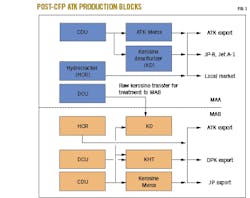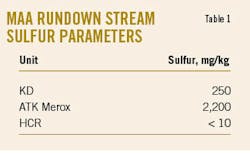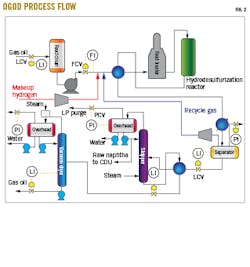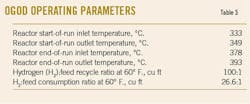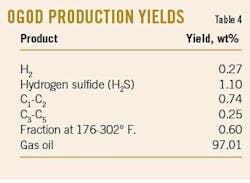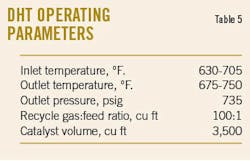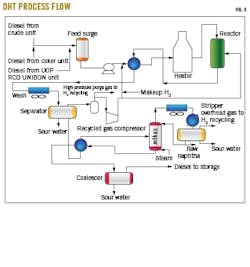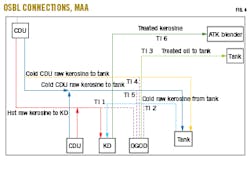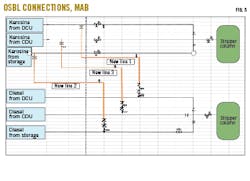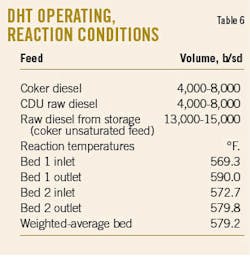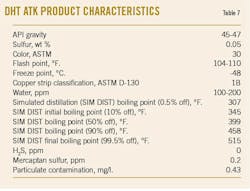KNPC hydrotreater conversions boost refineries’ flexibility
Mohammad B. Matar
Abdullah Mandani
Ahmed Al-Motawa
Ali I. Al-Mane
Maryam Al-Shatti
Kuwait National Petroleum Co.
Safat, Kuwait
Kuwait Petroleum Corp. (KPC) subsidiary Kuwait National Petroleum Co.’s (KNPC) Mina Al-Ahmadi (MAA) and Mina Abdullah (MAB) refineries recently converted an old gas oil desulfurization (OGOD) unit and obsolete diesel hydrotreater (DHT) to kerosine desulfurization service.
Alongside increasing the units’ operational flexibility during planned maintenance shutdowns, the in-house unit conversions also have helped control sulfur specifications of the refineries’ aviation turbine kerosine (ATK) production and manage kerosine inventories during shutdown. The unit revamps also have equipped the refineries with greater flexibility to modify production slates based on market demand.
This article discusses KNPC’s need for and approach to converting the hydrotreating units to kerosine desulfurization service, presenting lessons learned and benefits gained from the project.
MAA, MAB refineries
Following shutdown of its aging 200,000-b/sd Shuaiba refinery in April 2017 as part of its multibillion-dollar Clean Fuels Project (CFP) downstream initiative to meet growing global demand for cleaner and more sustainable fuels conforming to international standards, KNPC’s refining system consists solely of the MAA and MAB refineries in southern Kuwait, which operate as an integrated 800,000-b/sd refining system (OGJ Online, July 14, 2021).
Because of more stringent sulfur specifications in line with the CFP, MAA’s OGOD and MAB’s DHT were scheduled for decommissioning and demolition to make room for new units designed to ensure production of lower-sulfur domestic and export aviation fuels, including ATK, JP-8, Jet A-1, and dual-purpose kerosine (DPK).
Currently nearing its full-commissioning phase, KNPC’s CFP—which has involved a mix of unit additions, modifications, and retirements as part of reconfiguring and integrating the former 270,000-b/sd MAB and 466,000-b/sd MAA refineries to updated capacities of 454,000 b/sd and 346,000 b/sd, respectively—is designed for MAA and MAB treatment units to operate in different blocks. This coordinated approach ensures process units within each block are tightly integrated and coordinated across blocks to meet required production capacities as well as accommodate the refineries’ feedstock and product storage availability under different operating scenarios.
The CFP specifically outlined a revised configuration for the refineries’ ATK production blocks. This entailed tie-ins (TI) of existing processing units with grassroots units added as part of the CFP, which at MAA includes the 37,000-b/sd delayed coking unit (DCU), and at MAB, the new 264,000-b/sd crude distillation unit (CDU) and 39,000-b/sd kerosine hydrotreater (KHT) (Fig. 1).
Product specification, storage challenges
Ahead of decommissioning OGOD and DHT, KNPC’s MAA and MAB refineries were experiencing problems with storing untreated kerosine during turnaround shutdowns resulting from limited kerosine treatment capacity. The storage problem, in turn, was negatively impacting the refineries’ ability to meet various specifications for kerosine feedstock and treated product.
The sulfur content of raw kerosine normally falls within a range of 2,300-2,500 ppm, and historically, MAA and MAB easily managed meeting this specification during both normal operations and individual unit emergency shutdowns. Before changes to specifications for gas oil volumes sent to Kuwaiti power stations, MAA and MAB could comfortably blend excess raw kerosine at MAA and MAB into gas oil at various proportions to achieve on-spec product. The refineries’ option to blend excess amounts of either treated or raw kerosine streams gradually disappeared, however, as:
- Maximum sulfur content of gas oil supplied to power stations declined to 0.5 wt % from 1.0 wt % before further constricting to 500 ppm.
- Most power stations switched to gas-fired operations, reducing gas oil demand.
- Maximum sulfur content of Kuwait gas oil road diesel (gas oil) fell to 500 ppm from 2,000 ppm, and finally, to 10 ppm.
- Gas oil export specifications became more stringent, progressively narrowing to 2,000 ppm from 0.5% wt, then to 500 ppm, and ultimately to 10 ppm.
Even during scheduled shutdowns of MAA and MAB processing units, the combination of increasingly strict sulfur limits on and reduced demand for gas oil was resulting in large accumulations of surplus untreated kerosine that refineries would have to either transfer, store, or find ways to additionally treat to meet various domestic and export specifications.
Following the CFP’s full commissioning and the accompanying planned idling of OGOD and DHT, KNPC understood that sulfur levels in MAA’s ATK pool during normal operating conditions would be high, with any unscheduled upset or emergency shutdown of the refinery’s KD or HCR anticipated to further elevating these levels (Table 1). Any major planned or unplanned shutdowns of HCR or desulfurization units at MAA or MAB would also compound the buildup of raw kerosine that could not be stored or treated, creating logistical issues between the two refineries.
While KNPC schedules planned maintenance shutdowns of MAA and MAB’s integrated operating blocks to minimize buildup of intermediate kerosine stream inventories, the refineries’ operations remain vulnerable to unplanned disruptions during various unit shutdown scenarios. With raw kerosine ullage in intermediate storage tanks not meeting required specifications, inventory management can easily become compromised (Table 2). Other potential factors contributing to constraints in managing kerosine inventories include:
- Unscheduled shutdowns of MAA’s HCR and KD.
- DPK blending issues at MAB.
- Additional raw kerosine volumes to be generated in the future from KNPC’s proposed new CDU and bitumen production unit.
- Interruptions during transfer of raw kerosine from MAA’s DCU to MAB for further treatment.
Given the range of existing and foreseeable threats to kerosine inventory management at MAA and MAB during unit shutdowns—whether planned or unplanned—KNPC began exploring options to prevent and control both current and future inventory builds.
Project development, evolution
Initial studies conducted by external agencies to evaluate possible solutions to the refineries’ kerosine inventory issues concluded that KNPC would need to make sizeable investments in either adding new desulfurization capacity and storage tanks or executing major modifications to processing units at MAA and MAB scheduled to remain in operation following the full CFP commissioning.
In line with KNPC’s increased focus on reducing its overall capital and operating expenditures as well as maximizing use of its existing assets, MAA and MAB investigated the possibility of converting OGOD and DHT to kerosine service to help mitigate inventory constraints in lieu of their original plan to demolish the idled units.
Results of a front-end engineering design study on the potential unit modifications suggested the overall conversion project would take more than 4 years to complete and require major, costly changes to the units’ process configurations and equipment. Given previous experience with unforeseen work delays and unexpected costs typically associated with these types of externally executed projects, the refineries instead decided to conduct internal feasibility studies and on-site trial testing to determine in-house modifications that could help reduce the overall cost and duration of the unit revamps.
Revamp approach
Hydrotreating processes—which include desulfurization—are widely used in petroleum refining to meet increasingly stringent product specifications and environmental regulations. The aim of any hydrotreating process is to eliminate impurities that diminish production quality via catalytic hydrogenation. An HTU’s reaction section removes impurities such as sulfur from gas oil, with H2S and other dissolved gases subsequently removed in the unit’s stripping section.
Most hydrotreating units involve similar configurations, operations, and sometimes, even the same process technology. These similarities often allow operators flexibility to adapt a single unit to treat and upgrade an array of distillate feedstocks into on-spec fuels based on market demand.
MAA’s OGOD reactor includes a single catalyst bed and feed distributor that uses about 90 cu m of Haldor Topsoe AS’ TK-569 catalyst specifically developed for ultralow-sulfur diesel and kerosine applications, providing high hydrodesulfurization activity and stability when processing straight-run and cracked distillate fractions (Fig. 2).
Tables 3 and 4, respectively, show OGOD’s operating parameters and product yields.
MAB’s DHT already was equipped to use a similar catalyst to that frequently employed in kerosine treating, allowing the unit to process kerosine feed without extensive modifications.
Fig. 3 shows the process flow diagram for DHT, while Table 5 presents general operating parameters for the unit.
Based on internal feasibility studies for the project, MAB and MAA identified and executed a mix of outside battery limits (OSBL) TIs to accomplish the unit conversions (Figs. 4-5).
Notable OSBL TIs completed included the following:
- Installing new lines providing raw kerosine feed from CDUs and feed storage tanks to ensure units maintained adequate processing capacity.
- Installing feed TIs to connect hot coker kerosine and cold kerosine feeds to DHT’s feed headers.
- Rerouting gas oil lines from OGOD and DHT, directing ATK to finished-product storage tanks, DPK tanks, or the ATK blender.
- Rerouting DHT’s diesel rundown line to direct the unit’s finished product to the dehazing unit’s feed lines.
